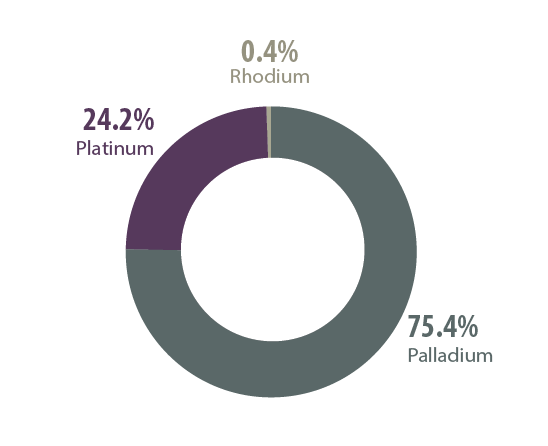
The platinum group metals (PGMs) consist of six metallic elements that share similar physical and chemical properties and often occur together in the same mineral deposits. These metals are:
- platinum
- palladium
- rhodium
- ruthenium
- osmium
- iridium
Key facts
- Canada is a major global producer of PGMs, ranking third in palladium production and fourth in platinum production.
- In 2023, Canada’s mine production of PGMs was approximately 702,000 troy ounces, with about three quarters originating from mines in Ontario.
- Recycling accounts for a notable portion of the global supply of PGMs.
Learn more about platinum group metals
 Uses
Uses
PGMs are highly valued for their strong catalytic properties, which enable them to accelerate or initiate chemical reactions without being permanently altered. Their primary use is in the production of catalytic converters, a critical component of exhaust systems in internal combustion vehicles.
Platinum and palladium are key materials in autocatalysts, reducing harmful tailpipe emissions from cars, buses, and trucks, thereby contributing to cleaner air.
Beyond automotive applications, PGMs—particularly platinum, iridium, and ruthenium—play a vital role in the development of clean hydrogen technologies. These technologies, increasingly important in both transportation and power generation, support the global shift toward a net-zero economy.
Platinum is also widely used across diverse industries, including chemicals, glass manufacturing, electronics, medical devices, petroleum refining, and jewellery. Palladium serves similar industrial purposes, especially in the chemical, electronics, and dental sectors.
Although platinum and palladium have an investment component, it remains a smaller part of their broader use.
Rhodium is often added to three-way catalytic systems (platinum-palladium-rhodium) for gasoline-powered vehicles to reduce nitrogen oxide (NOx) emissions.
Iridium and ruthenium are integral to chemical, electronic, and electrochemical applications, with their use expected to expand in hydrogen production and fuel cell technologies.
Platinum group metals, global uses, 2023
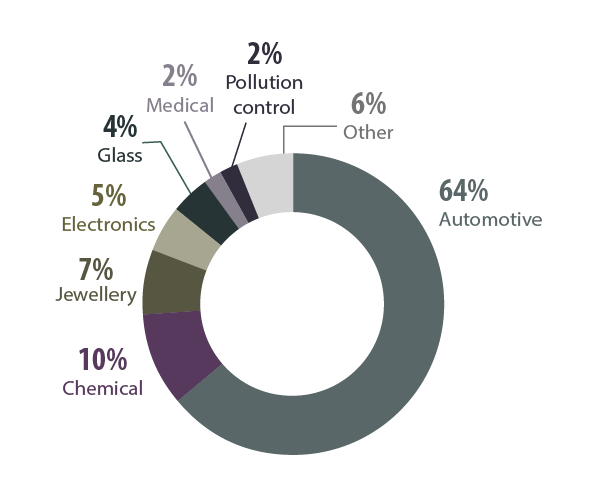
Text version
This circular chart illustrates the primary industrial applications of PGMs in 2023. The automotive sector represented the largest share at 64%, followed by chemical (10%), jewellery (7%), electronics (5%), glass (4%) medical (2%), pollution control (2%), and various other uses (6%).
 Production
Production
In 2023, Canadian mines produced 702,000 troy ounces of PGMs and shipped 696,000 troy ounces. Most of the production came from Ontario, which accounted for 76% of the total, while the remaining production occurred in Quebec, Manitoba, and Newfoundland and Labrador.
Canada has one dedicated PGM mine, the Lac des Iles mine, located in western Ontario near Thunder Bay. Additionally, PGMs are recovered as co-products at numerous primary nickel mines across the country. Currently, there are three advanced exploration projects in northern Ontario specifically targeting PGMs as their primary commodities.
Consult a map of producing Canadian mines
Canadian mine production of platinum group metals, 2014–2023 (p)
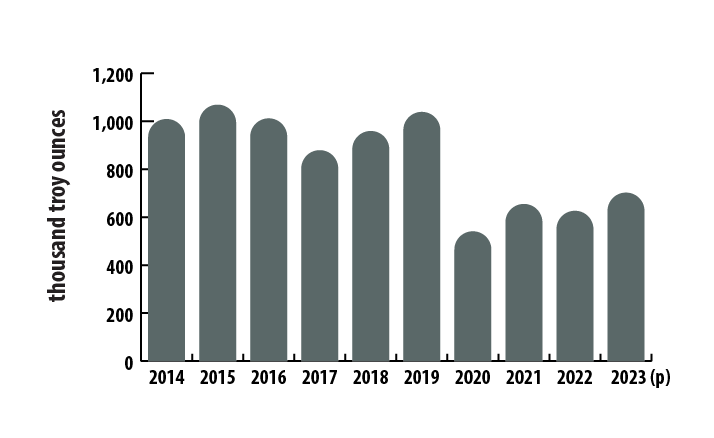
Text version
This bar graph illustrates Canada’s annual PGM mine production from 2014 to 2023. Production began at 1.01 million troy ounces in 2014, reaching a peak of 1.07 million troy ounces in 2015, before falling to 879,000 troy ounces in 2017. It then climbed to 1.04 million troy ounces in 2019, followed by a sharp decline to 541,000 troy ounces in 2020. Production rebounded to 655,000 troy ounces in 2021, dipped slightly to 626,000 troy ounces in 2022, and rose by 12% to 702,000 troy ounces in 2023.
 International context
International context
Canada is the fourth-largest producer of mined PGMs in the world, accounting for approximately 5.3% of global production. An estimated 17.4 million troy ounces of PGMs was supplied globally in 2023, 75% of which was from mined sources, and the balance was from recycling and scrap sources.
World mine production of platinum group metals, by country, 2023 (p)
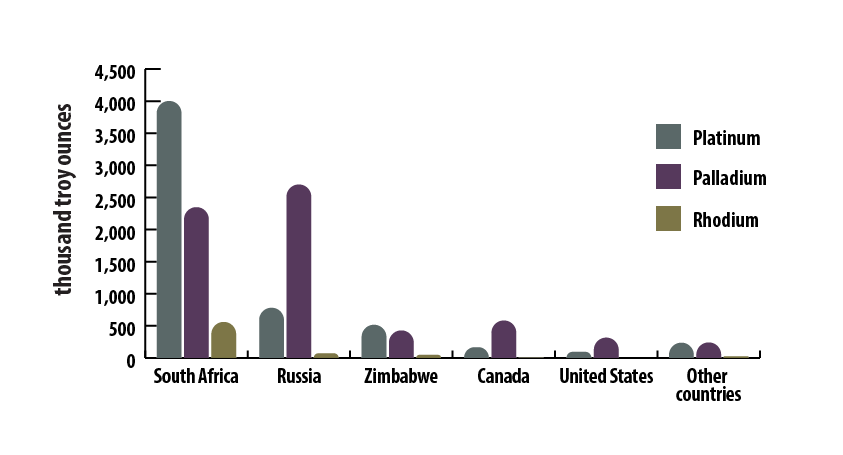
Text version
This bar graph illustrates the estimated global production of platinum, palladium, and rhodium in 2023, measured in thousands of troy ounces, by country. The top producers are:
- South Africa: platinum (4,001,000 oz.), palladium (2,347,000 oz.), rhodium (559,000 oz.)
- Russia: platinum (780,000 oz.), palladium (2,700,000 oz.), rhodium (70,000 oz.)
- Zimbabwe: platinum (515,000 oz.), palladium (427,000 oz.), rhodium (46,000 oz.)
- Canada: platinum (166,000 oz.), palladium (518,000 oz.), rhodium (3,000 oz.)
- United States: platinum (93,000 oz.), palladium (315,000 oz.)
- Other countries: platinum (236,000 oz.), palladium (240,000 oz.), rhodium (23,000 oz.)
| Rank | Country | Palladium (kg) | Platinum (kg) | Total |
|---|---|---|---|---|
| 1 | South Africa | 71,000 | 120,000 | 191,000 |
| 2 | Russia | 92,000 | 23,000 | 115,000 |
| 3 | Zimbabwe | 15,000 | 19,000 | 34,000 |
| 4 | Canada | 16,100 | 5,200 | 21,300 |
| 5 | United States | 9,800 | 2,900 | 12,700 |
| - | Other countries | 2,700 | 4,600 | 7,300 |
| Total | - | 209,600 | 174,700 | 381,300 |
World production of platinum group metals, including recycling, 2014–2023 (p)
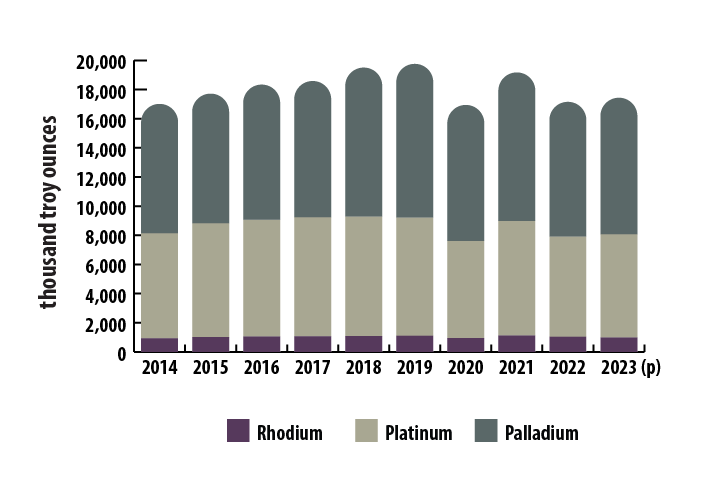
Text version
This bar graph illustrates the global annual production of PGMs from 2014 to 2023, including platinum, palladium, and rhodium. In 2014, production stood at 17.0 million troy ounces, rising to a peak of 19.8 million troy ounces in 2019. However, production dropped to 16.9 million troy ounces in 2020 due to supply chain disruptions caused by the COVID-19 pandemic. In 2021, production rebounded by 13%, reaching 19.2 million troy ounces, but then declined by 11% in 2022 to 17.1 million troy ounces. A modest 2% increase in 2023 brought total production to 17.4 million troy ounces.
In 2023, global proven reserves of PGMs were estimated at 70,830 tonnes, or 2.3 billion troy ounces, with the majority located in South Africa. Canada holds the fifth-largest known PGM reserves globally, totalling 310 tonnes, or roughly 10 million troy ounces.
| Rank | Country | Tonnes | Percentage of total |
|---|---|---|---|
| 1 | South Africa | 63,000 | 88.9% |
| 2 | Russia | 5,500 | 7.8% |
| 3 | Zimbabwe | 1,200 | 1.7% |
| 4 | United States | 820 | 1.2% |
| 5 | Canada | 310 | 0.4% |
| - | Other countries | N/A | N/A |
| Total | - | 70,830 | 100.0% |
 Trade
Trade
Exports
In 2023, Canada’s domestic exports of refined (Stage 2) and semi-fabricated (Stage 3) PGM products reached 6,995 kg, valued at $400 million—a 21% decline in value and a 1% drop in volume compared to 2022. Palladium-based products made up 81% of the volume and accounted for 89% of the value, while platinum-based products represented 9% of the volume and 7% of the value. Rhodium-based products comprised less than 0.1% of both volume and value.
The United States was the destination for 73% of the total export value of Canada’s unwrought, powder, or semi-manufactured PGMs, followed by Switzerland (23%), and Germany and China (2% each).
Quebec led the nation in exports, contributing 84% of the total value ($336 million), while Ontario accounted for 12% ($49 million).
Imports
In 2023, Canada imported 26,212 kg of refined (Stage 2) and semi-fabricated (Stage 3) PGM products, valued at $1.5 billion. This represents a 44% drop in value, despite an 11% increase in volume compared to 2022. Palladium accounted for 80% of the import volume and 63% of the value, with platinum at 11% of the volume and 7% of the value. Rhodium made up 7% of the volume but 29% of the value, while iridium, osmium, and ruthenium combined for 2% of the volume and 1% of the value.
Canada’s PGM imports were sourced from several key countries: South Africa accounted for 39% of the total import value, followed by the United States with 25%, South Korea at 12%, Belgium at 9%, Germany at 5%, Switzerland at 4%, Japan at 3%, and Italy at 2%.
 Prices
Prices
Platinum prices saw a strong start in 2023 but declined steadily in the second half of the year. Beginning at $1,053 per troy ounce in January, prices dipped to $959 in February, then rose to a peak of $1,062 in May. However, they fell to a low of $892 in October before closing the year at $935 per troy ounce in December. The annual average price in 2023 was $966 per troy ounce, nearly unchanged from 2022. Platinum prices remained relatively stable compared to other PGMs, supported by ample above-ground stocks due to surpluses from 2021–2022.
Palladium prices, on the other hand, dropped sharply throughout 2023. The monthly average fell from a high of $1,732 per troy ounce in January to a low of $1,050 in November. The annual average was $1,338 per troy ounce, significantly down from $2,108 in 2022. This decline was driven by increased palladium supply, as concerns about supply disruptions eased and consumer stockpiling diminished. Palladium availability is expected to rise in the medium term as demand weakens, with the declining share of internal combustion engine (ICE) vehicles in favour of electric vehicles (EVs).
Rhodium prices also fell sharply in 2023 due to increased supply and expectations of weakening demand.
Platinum, monthly average prices, 2014–2023
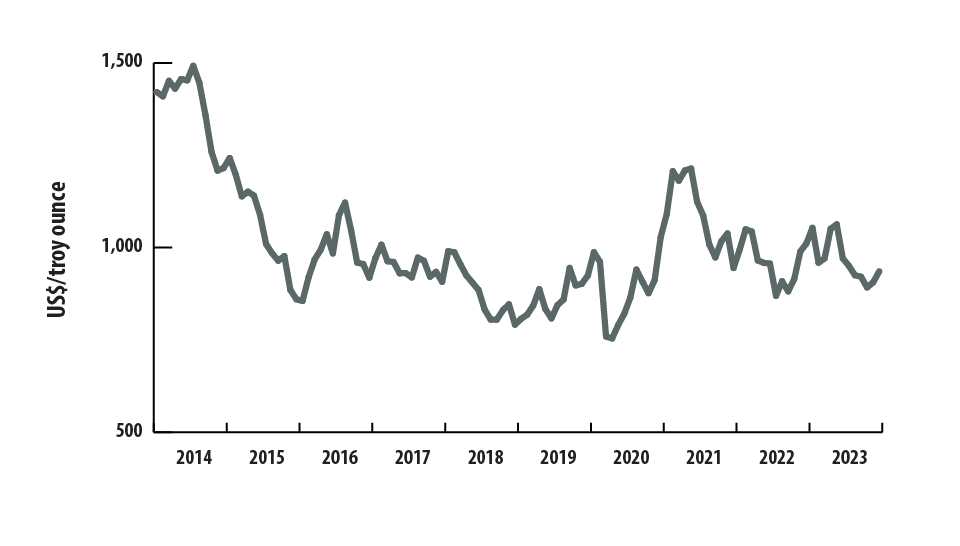
Text version
This line graph illustrates the monthly average price of platinum, in U.S. dollars per troy ounce, from 2014 to 2023. In 2014, the annual average price was $1,384 per troy ounce. Prices fluctuated between 2014 and 2016 but trended downward overall. From 2016 to 2020, prices remained relatively stable, ranging between $700 and just over $1,000 per troy ounce. In 2021, the average annual price rose to $1,091 per troy ounce, before falling to $962 in 2022. In 2023, prices began at $1,053 per troy ounce in January, dipped to $959 in February, and peaked at $1,062 in May. By October, prices dropped to a low of $892 per troy ounce, ending the year with an annual average of $966, similar to the previous year.
Palladium, monthly average prices, 2014–2023
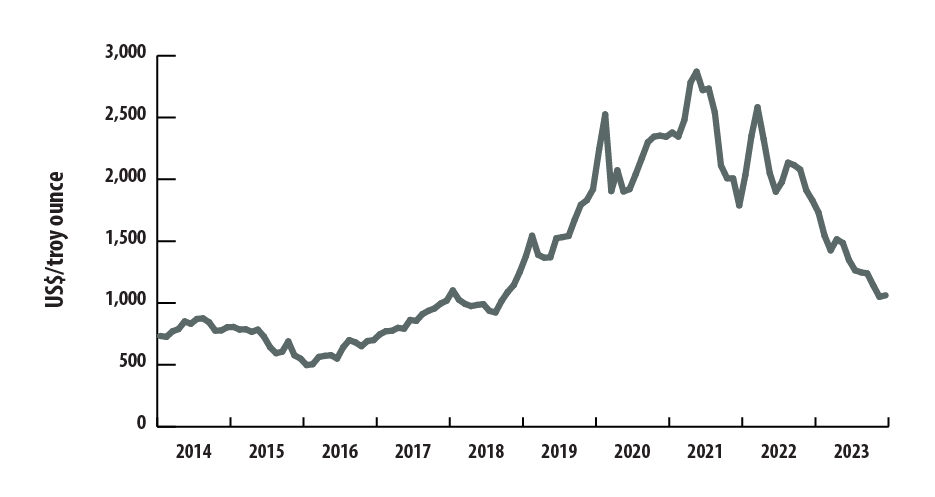
Text version
This line graph illustrates the monthly average price of palladium in U.S. dollars per troy ounce from 2014 to 2023. In 2014, the average annual price was $805 per troy ounce. Prices remained relatively stable between 2014 and 2016, fluctuating between $498 and $876 per troy ounce. After 2016, palladium prices rose steadily, with annual averages reaching $869 in 2017, $1,036 in 2018, and $1,572 in 2019. In early 2020, prices peaked at $2,525 per troy ounce before the onset of the COVID-19 pandemic, then dropped to $1,902 per troy ounce by May. From 2020 to 2022, prices were highly volatile, with monthly averages ranging from $1,789 to $2,870 per troy ounce. The average annual prices were $2,177 in 2020, $2,397 in 2021, and $2,108 in 2022. In 2023, palladium prices declined steadily, starting at $1,732 per troy ounce in January and falling to a low of $1,050 in November. The annual average price for 2023 was $1,338 per troy ounce.
 Recycling
Recycling
In 2023, 4.4 million troy ounces of PGMs were recovered from the recycling of products such as autocatalytic converters, electrical scrap, and jewellery. Recycling accounted for 25% of the total global supply of PGMs in 2023, with the balance coming from mining. The high value of PGMs, combined with their significant concentrations in recyclable materials, drives substantial levels of PGM recycling.
World supply of platinum group metals, by source, 2023
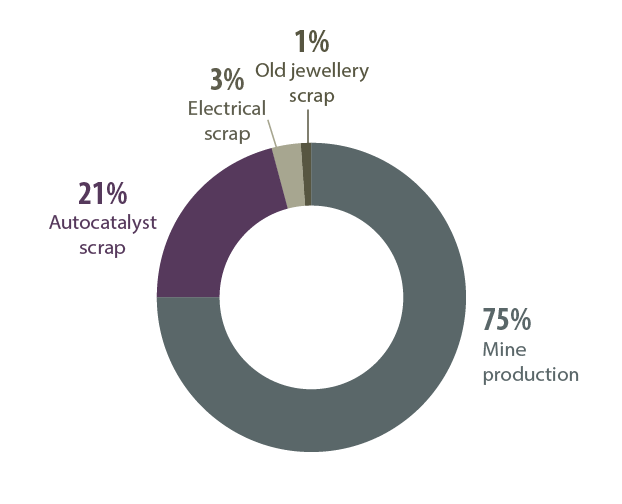
Text version
This pie chart illustrates the global supply of PGMs by source in 2023, expressed as a percentage. The primary source was mine production, which constituted 75% of the total supply. Recycling sources included autocatalyst scrap at 21%, electrical scrap at 3%, and old jewellery scrap at 1%. In total, recycled materials accounted for 25% of the overall production.
Notes and sources
(p) preliminary
Totals may be different because of rounding.
All dollars are Canadian unless indicated otherwise.
Uses
- Platinum group metals, global uses, 2023
- Johnson Matthey, PGM market report, May 2024
Production
- Canadian mine production of platinum group metals, 2014–2023 (p)
- Natural Resources Canada
- Canadian mine production of platinum group metals, by element, 2023 (p)
- Johnson Matthey, PGM market report, May 2024
- United States Geological Survey; Mineral Commodity Summaries 2024
International context
- World mine production of platinum group metals, by country, 2023 (p)
- Johnson Matthey, PGM market report, May 2024
- World mine production of platinum and palladium, by country, 2023 (p)
- United States Geological Survey; Mineral Commodity Summaries 2024
- World production of platinum group metals, including recycling, 2014–2023 (p)
- Johnson Matthey, PGM market report, May 2024
- World reserves of platinum group metals, by country, 2023 (p)
- U.S. Geological Survey
Trade
- Natural Resources Canada
- Mineral trade includes unwrought, powders, and semi-fabricated mineral products (HS codes: 711011, 711019, 711021, 711029, 711031, 711039, 711041, 711049).
Prices
- Johnson Matthey, PGM market report, May 2024
- Platinum, monthly average prices, 2014–2023
- World Bank
- Palladium, monthly average prices, 2014–2023
- London Metal Exchange
Recycling
- World supply of platinum group metals, by source, 2023
- Johnson Matthey PGM market report, May 2024
